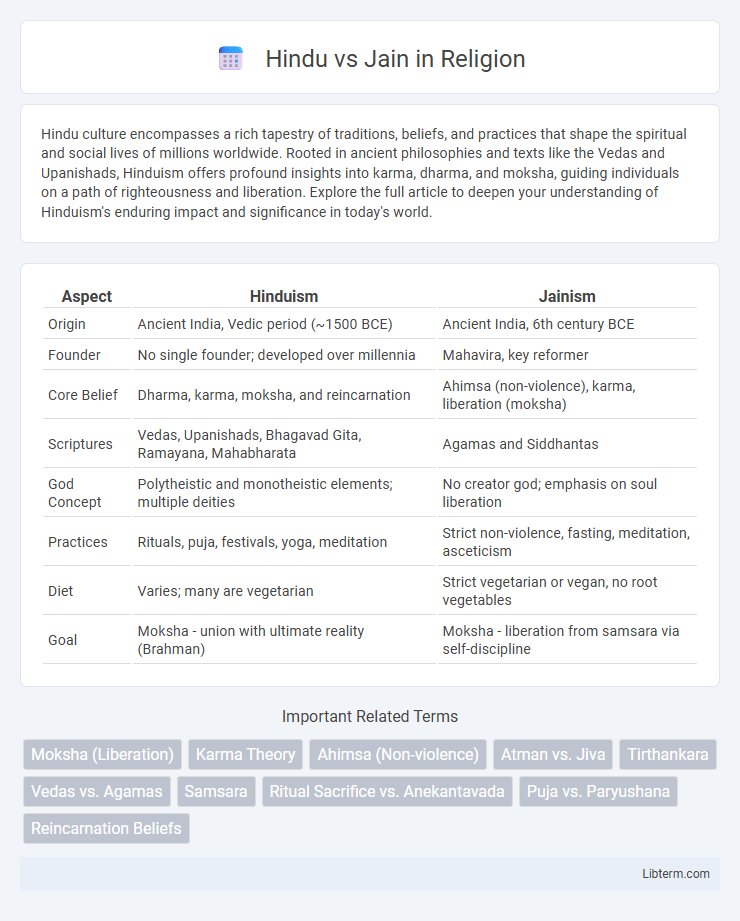Hindu culture encompasses a rich tapestry of traditions, beliefs, and practices that shape the spiritual and social lives of millions worldwide. Rooted in ancient philosophies and texts like the Vedas and Upanishads, Hinduism offers profound insights into karma, dharma, and moksha, guiding individuals on a path of righteousness and liberation. Explore the full article to deepen your understanding of Hinduism's enduring impact and significance in today's world.
Table of Comparison
| Aspect | Hinduism | Jainism |
|---|---|---|
| Origin | Ancient India, Vedic period (~1500 BCE) | Ancient India, 6th century BCE |
| Founder | No single founder; developed over millennia | Mahavira, key reformer |
| Core Belief | Dharma, karma, moksha, and reincarnation | Ahimsa (non-violence), karma, liberation (moksha) |
| Scriptures | Vedas, Upanishads, Bhagavad Gita, Ramayana, Mahabharata | Agamas and Siddhantas |
| God Concept | Polytheistic and monotheistic elements; multiple deities | No creator god; emphasis on soul liberation |
| Practices | Rituals, puja, festivals, yoga, meditation | Strict non-violence, fasting, meditation, asceticism |
| Diet | Varies; many are vegetarian | Strict vegetarian or vegan, no root vegetables |
| Goal | Moksha - union with ultimate reality (Brahman) | Moksha - liberation from samsara via self-discipline |
Introduction to Hinduism and Jainism
Hinduism, one of the world's oldest religions, centers on concepts like Dharma (duty), Karma (action and consequence), and Moksha (liberation from the cycle of rebirth). Jainism, founded around the 6th century BCE by Mahavira, emphasizes strict non-violence (Ahimsa), self-discipline, and asceticism to achieve spiritual purity. Both religions originated in India and share beliefs in karma and reincarnation but differ significantly in practices and interpretations of liberation.
Historical Origins and Development
Hinduism originated around 1500 BCE in the Indian subcontinent, rooted in the Vedic traditions and evolving through diverse scriptures like the Upanishads, Bhagavad Gita, and epics such as the Mahabharata and Ramayana. Jainism emerged around the 6th century BCE, founded by Mahavira, emphasizing non-violence (ahimsa) and strict asceticism as central doctrines, distinct from the ritualistic practices of early Hinduism. Both religions developed parallel philosophical frameworks and influenced each other culturally, yet Jainism maintains unique principles of karma and liberation that differentiate its historical trajectory.
Core Philosophical Beliefs
Hindu philosophy centers on concepts like dharma, karma, moksha, and the belief in a supreme, all-encompassing Brahman, emphasizing diverse paths such as devotion, knowledge, and meditation to achieve liberation. Jain philosophy prioritizes non-violence (ahimsa), truth (satya), and asceticism as essential virtues, advocating for strict self-discipline to free the soul from karma and attain ultimate liberation (moksha). Both systems recognize karma and liberation but differ in metaphysical views, where Hinduism embraces a broader theological framework and Jainism maintains a dualistic approach separating soul and matter.
Major Deities and Spiritual Leaders
Hinduism worships a vast pantheon including major deities such as Vishnu, Shiva, and Durga, each representing different aspects of the divine and cosmic functions. Jainism focuses on spiritual ideals rather than gods, venerating the Tirthankaras like Mahavira, who exemplify ultimate liberation through strict ethical conduct and nonviolence. While Hinduism embraces diverse theistic traditions and devotional practices, Jainism emphasizes self-discipline, non-attachment, and the path to enlightenment through inner purification rather than divine intervention.
Rituals and Religious Practices
Hindu rituals typically involve elaborate ceremonies such as puja, yajna, and samskaras, emphasizing offerings to deities and participation in festivals like Diwali and Holi. Jain practices focus on strict non-violence (ahimsa), meditation, and rituals such as Paryushana, which emphasize self-discipline, fasting, and repentance. Both traditions value daily prayers, but Jain rituals often avoid idol worship, contrasting with the diverse deity worship common in Hinduism.
Concepts of Karma and Liberation
Hinduism's concept of karma emphasizes the cycle of birth, death, and rebirth (samsara), where actions influence future lives, with liberation (moksha) achieved through devotion, knowledge, and righteous living. Jainism's karma doctrine is more mechanistic, viewing karma as a physical substance binding the soul, and liberation (kevala) occurs by purging all karmic particles through strict non-violence and asceticism. Both traditions value liberation but differ fundamentally in the nature of karma and the path to freedom.
Attitudes Toward Non-Violence and Ahimsa
Hinduism and Jainism both emphasize ahimsa, but Jainism adopts a more rigorous approach to non-violence, extending it to all living beings with strict practices such as sweeping paths to avoid harm to insects. Hinduism incorporates ahimsa as a key ethical principle, especially in spiritual and dietary practices, but permits more flexibility in daily life and warfare contexts. Jainism's absolute commitment to non-violence shapes its ascetic lifestyle, whereas Hinduism balances ahimsa with Dharma and social responsibilities.
Sacred Texts and Scriptures
Hinduism's sacred texts include the Vedas, Upanishads, Bhagavad Gita, and Ramayana, which form a vast corpus of hymns, philosophy, and epic narratives reflecting diverse spiritual teachings. Jainism's scriptures primarily consist of the Agamas, canonical scriptures based on the teachings of Lord Mahavira, emphasizing non-violence, truth, and asceticism. While Hindu texts explore a broad spectrum of deities and metaphysical concepts, Jain texts focus on ethical conduct and liberation through self-discipline.
Festivals and Observances
Hindu festivals such as Diwali, Holi, and Navratri involve elaborate rituals, vibrant celebrations, and regional variations reflecting diverse deities and cultural narratives. Jain festivals like Paryushana and Mahavir Jayanti emphasize spiritual purification, non-violence, fasting, and meditation, underscoring core principles of Jainism. Both traditions observe rituals that foster community bonding, but Jain festivals prioritize asceticism and self-discipline more intensely than Hindu celebrations.
Social Impact and Contemporary Relevance
Hinduism and Jainism have significantly shaped Indian social structures, with Hinduism influencing caste dynamics and rituals, while Jainism emphasizes non-violence and ethical commerce. Both religions contribute to contemporary debates on environmental sustainability and social justice, as Jain principles inspire vegetarianism and non-harm, whereas Hindu festivals and practices foster communal unity. The enduring relevance of these traditions is evident in their roles within modern philanthropy, education, and cultural preservation across India.
Hindu Infographic

 libterm.com
libterm.com